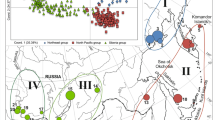Abstract:
We examined population genetic structure by means of microsatellite analysis among 7 Japanese flounder (Paralichthys olivaceus) populations collected from coastal sea areas around Japan. As was expected, all of the 11 microsatellite loci examined were variable in all populations (number of alleles per locus, 15.2–18.2; average of expected heterozygosity, 0.74–0.78). Eleven population pairs in 21 possible pairwise comparisons showed significant genetic heterogeneity associated with allele frequency distributions or fixation index (F ST ). Modified Cavalli-Sforza chord distance (D A ) and Nei's standard genetic distance (D ST ) ranged from 0.051 to 0.090, and from 0.000 to 0.025, respectively. There was evidence that the populations assessed in this study were not drawn from a single panmictic population; however, it appears that Japanese flounder populations around Japan are not well-structured, as an estimate of the fixation index value among the 7 localities was very low (F ST = 0.0025).
Similar content being viewed by others
Author information
Authors and Affiliations
Additional information
Received April 27, 2001; accepted June 27, 2001.
Rights and permissions
About this article
Cite this article
Sekino, M., Hara, M. Application of Microsatellite Markers to Population Genetics Studies of Japanese Flounder Paralichthys olivaceus . Mar. Biotechnol. 3, 572–589 (2001). https://doi.org/10.1007/s10126-001-0064-8
Issue Date:
DOI: https://doi.org/10.1007/s10126-001-0064-8




